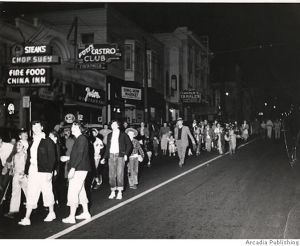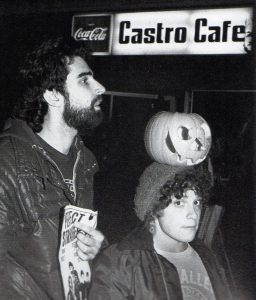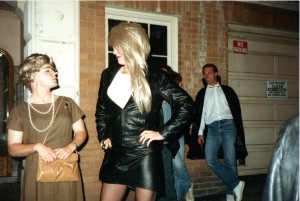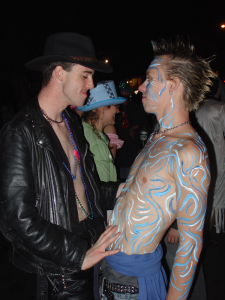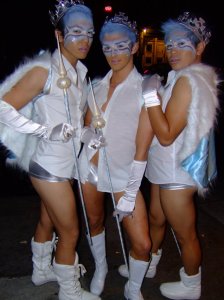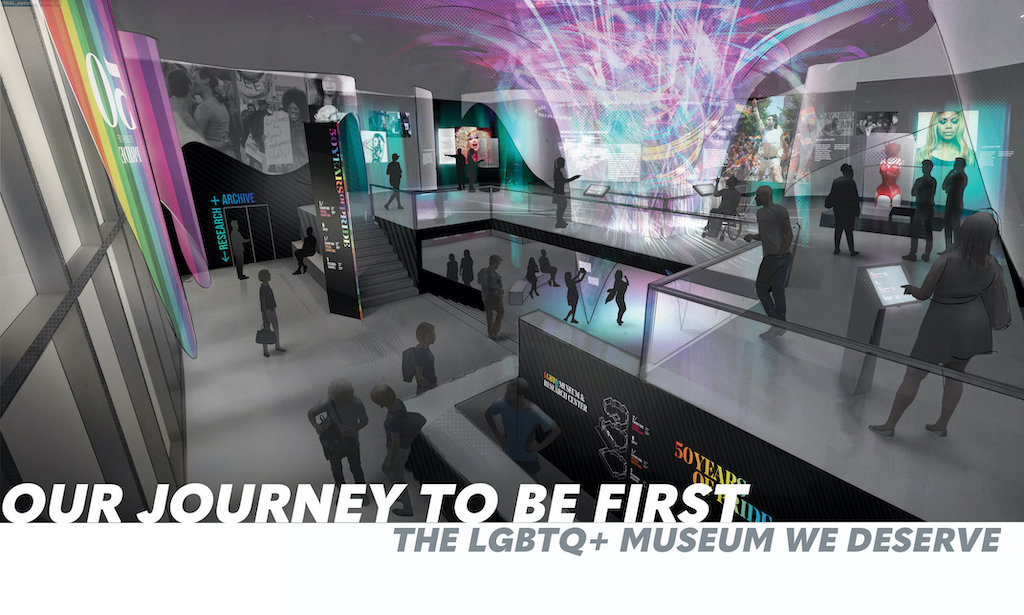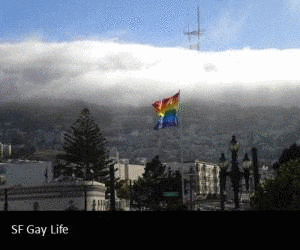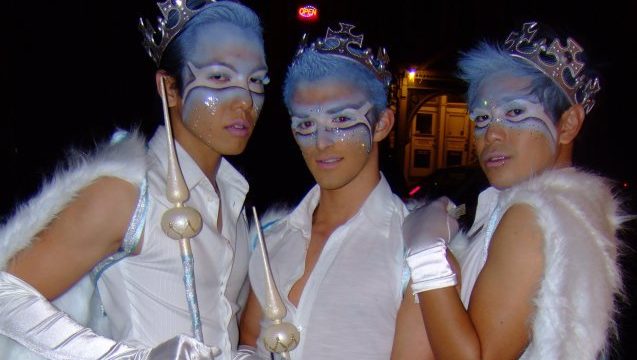
SF’s Gay Halloween – Part 4
More than three decades of Halloween in the gayborhood
For more than three decades now, the Castro’s gay Halloween celebrations have been infamous. But even before the gays moved in, the neighborhood had its own Halloween traditions.
Early Halloween celebrations in Eureka Valley
In 1946, Ernie DeBaca – owner of Cliff’s Variety Store on Castro Street and son of its founder, Hilario DeBaca – created a Halloween costume parade for the mostly Scandinavian and Irish children who lived in the neighborhood that was then known as Eureka Valley (or Most Holy Redeemer Parish for the neighborhood’s Catholics).
This quickly grew in 1948 to a costume and ice cream eating contest on a stage created outside Cliff’s, with DeBaca, a.k.a. “Grandpa Ernie,” serving as the judge.
Here come the gays
The neighborhood’s first gay bar, the Missouri Mule, opened on Upper Market in 1963. A few other gay bars opened by the end of the decade, and by the early 1970s, gay businesses were cropping up everywhere.
Ernie DeBaca was one of the few to welcome gays. Cliff’s was one of the first neighborhood businesses to hire openly gay clerks, and the store gladly helped new gay homeowners renovate and gentrify their aging Victorian homes.
Since the streets were already closed for the costume contest, it was natural for the gays to spill out of the bars to party in the streets. Some gays and hippies started to enter Cliff’s costume contest, which the DeBeca’s family says startled Ernie but mostly amused him. The contest continued until 1979, when the place for gays to party on Halloween officially jumped from the Polk to Castro Street after too many incidences of gay bashings in the Tenderloin and the Polk.
The Sisters and CUAV step in
For years, the Halloween celebrations in the Castro were informal affairs. The Saturday before was a more localized event for the neighborhood, while the actual day of Halloween would bring in costumed gays from throughout the Bay Area.
In 1989, just weeks after the Loma Prieta Earthquake, the Sisters of Perpetual Indulgence stepped in to turn the party into an impromptu fundraiser for earthquake relief efforts.
The following year, the Sisters formally took over organizing the event, joining with Community United Against Violence (CUAV) to add security gates and a stage for performances, train safety monitors, provide safety whistles, and document incidences of violence. For a time it appeared that some sense of structure and organization would be added to the neighborhood’s annual “spontaneous” party.
The word gets out
For a time, Halloween in the Castro was a localized and gayish event. People in the neighborhood knew about it and participated, gays and straights alike. Many had friends come over to join in the festivities, gays and straights alike. Gay people throughout the Bay Area came down to participate, hearing about the party through their friends or the gay press.
But sometime in the early ’90s, word got out through the mainstream media. Television news crews set up live coverage at the corner of 17th and Castro. Others started coming into the Castro for the party, not to celebrate with their friends but to gawk at the spectacle.
Some saw it as something flashy and fun and exciting, like Mardi Gras only gayer. Some saw it as an opportunity to get drunk in the streets – especially those under 21. Some saw it as an opportunity to gawk at the freaks and the queers. And too many straight guys, uncomfortable being around so many queers, got dragged there by their girlfriends and became a bit belligerent once they had a few too many drinks.
After the 1995 celebration, the liability risks grew to be too great and the Sisters of Perpetual Indulgence and CUAV both withdrew their involvement. The Sisters tried to get gays to move the party out of the neighborhood by sponsoring a dance at a SOMA nightclub, but though their event was successful, the Castro was as crowded as ever. CUAV organized an event at Civic Center, where the annual Pride celebration is held.
Around the same time, the Sisters of Perpetual Indulgence revived Cliff’s costume contest with a new event for children at the Eureka Valley Recreation Center. Cliff’s Variety continued to participate by providing prizes for the winners.
CUAV reportedly lost a lot of money on the 1996 celebration at the Civic Center. In 1997, the Mission Economic and Cultural Association stepped in to produce the Civic Center party. But efforts to draw attention away from the gays celebrating in the Castro never really took off.
Shit gets real
Despite the lack of an official organizer, the parties continued in the Castro. Unruly elements looking for trouble also continued to come.
In 2002, four or five people were stabbed, one person brought a working chainsaw as a part of his costume, and numerous people reported being assaulted. In response, the city’s Entertainment Commission stepped in to oversee safety plans, including alcohol and weapon searches as revelers entered the closed-off areas.
In 2003, police attempted to reduce the violence by trying to curb the flow of alcohol on the streets. They frisked people as they entered the closed-off streets, confiscating weapons and alcohol. ABC officers tried to crack down on bars offering “to go” cups from their windows.
In 2006, things got out of hand around 10:30 when the music stopped. A porta-potty was overturned and bottles were reportedly thrown. Then farther down Market Street, just a few blocks from the epicenter of the party, someone shot a gun into a crowd of people, injuring nine of them – none fatally.
The party was over.
The end of street closures
Immediately after the violence of 2006, city officials stepped in to figure out how to move the party out of the neighborhood. The city discussed creating a Task Force to plan for the Castro’s activities. A huge waterfront festival near AT&T Park was planned to draw partiers into a more controllable area.
But in the end, the City dropped the ball. The Task Force was never created. The waterfront festival was a dud when the party promoter hired to organize the event pulled out in August due to health reasons. Instead, the City developed a “Home for Halloween” marketing campaign encouraging people to stay holed up inside. Police insisted that the streets would not be closed off and people blocking traffic would be arrested. The City strong-armed Castro bars into agreeing to close for the evening, one of their busiest nights of the year, even though bar patrons were never the source of the problems.
Castro residents continued to have their own scaled-down Halloween on the Saturday before, but the neighborhood was very quiet on Wednesday, October 31st.
In 2008, bars were allowed to remain open but the street party was done. The streets remained open to automobile traffic, but costumed revelers still mingle on the sidewalks as they go from bar to bar.
Six years later, things remain the same: party in bars or private homes, not the streets. Club promoters like Gus Presents throw large-scale club events in SOMA nightclubs. And many gays have turned to house parties to avoid potential mayhem in the streets.
